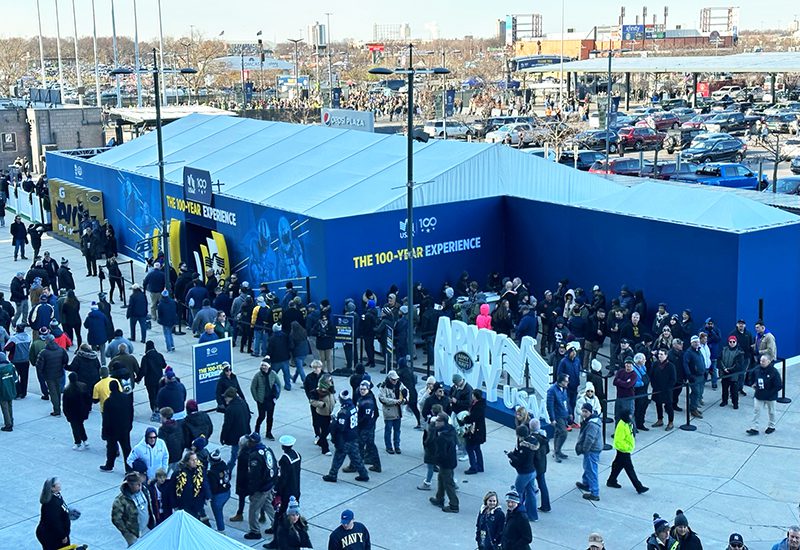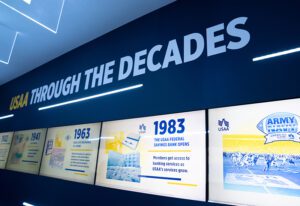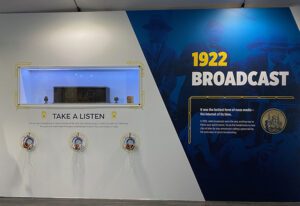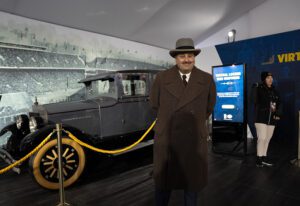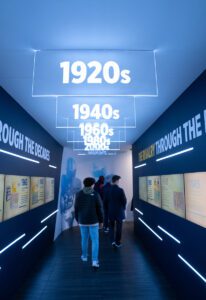
Fans walked through a portal displaying key moments in Army-Navy game history, and “into the future.”
As the presenting sponsor of the Army-Navy football game since 2009, USAA never approaches each year’s game-day experiential activation the same way. But the 2022 matchup on Dec. 10, at Lincoln Financial Field in South Philadelphia, provided USAA with a unique opportunity to dial up its sponsorship experience in conjunction with its 100th anniversary campaign. The result: an interactive museum that took fans back in time to showcase the game’s evolution over 123 years, and the association’s evolution over 100 years, with personalized engagements, physical recreations and interactive technology.
“We do in-depth research each year of the fans and our members, and we get a pulse on the community of what their wants and needs are around the Army-Navy game,” says James Rini, lead marketing manager at USAA, which provides insurance, banking, retirement and investment services for military families. “So, the activation is new and exciting each year, but around the 100th year, we wanted it to be our largest.”
According to USAA data, fans reported they valued free swag or memorabilia, a quick registration process, opportunities for “digital gain,” and having physical, historical touchpoints. “We actually incorporated all of that,” Rini says.
The 6,525-square-foot free exhibit inside the stadium Fan Fest featured a 3D lenticular design on the exterior that switched from the Army logo to the Navy logo as fans moved along the queue line. Once inside, they registered to receive a physical vintage-style ticket with a QR code that unlocked and personalized 10 experiences throughout the activation tent. The “ticket” was significant in that in 2021, Army-Navy game tickets went entirely digital. Prior to that, fans often collected their ticket stubs as keepsakes. USAA brought that back for them.
 More on Sports Sponsorship:
More on Sports Sponsorship:
- How Coca-Cola Brought ‘Real Magic’ to Fans Along the FIFA World Cup Trophy Tour
- Rolling Coverage: Steal-worthy Brand Activation Ideas from Super Bowl LVI in Los Angeles
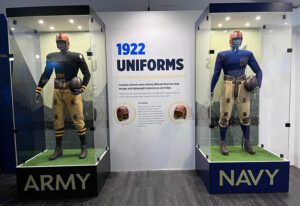
A costume designer was enlisted to re-create Army and Navy uniforms from 1922, then USAA wired the mannequins with AR.
The experience featured three zones, beginning with a 1922 space that spotlighted USAA’s founding by 25 Army officers and allowed fans to explore how the Army-Navy game looked, sounded and was marketed back then.
The team re-created any artifacts that didn’t exist anymore by working with craftspeople and the schools’ history departments. For example, 1920s Army and Navy uniforms were re-created by an Academy Award-nominated costume designer and put on display. But the experience took it a step further. Adjacent to the 1922-uniformed mannequins was an augmented reality kiosk that allowed fans to “try on” the 1922 Army or Navy uniform. When they scanned their ticket stub, the engagement recognized their name and what team they were rooting for, and displayed that particular uniform on them. Fans could then move around and have their photo taken with the uniform “on.” That image was sent to them instantly for sharing.
Other experiences included a listening station where fans could hear what the 1922 broadcast likely sounded like. Sound bites from the games don’t exist from that era, so the team re-created a broadcast (complete with a transatlantic accent) and allowed fans to listen with headsets to how the game was consumed back then over radio.
There was also an original Elcar on display, brought in from USAA headquarters in San Antonio, TX—one of the first vehicles the association ever insured—in an activation designed to showcase what tailgating might have looked like in 1922. Brand ambassadors and a USAA employee who maintains the vehicle dressed in period costume and interacted with fans.
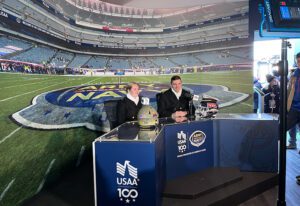
Fans were invited to “call the game” from a broadcast TV desk and received a shareable version of their segment afterwards.
Lastly, the team was able to secure one of the only 1922 Army-Navy game programs on record and digitized it for the experience to allow fans to swipe through and watch it come to life through different animations.
But wait, there’s more. Next, fans headed through a “portal,” a tunnel that transported them from the 1920s to present day with historical milestones of USAA and the Army-Navy game on either side—including one of the first instant replays every introduced at the game (in 1963). They emerged in the 2022 game-day zone where the 2022 Army and Navy uniforms were on display and MCs hyped up the fans to “energize” the space.
Fans could take part in a “Call the Game” opportunity and record their own Army-Navy game play call from a broadcast TV desk complete with a teleprompter and script for them to read. Behind them was a backdrop that made it look like they were broadcasting right from the game. Their “segment” was then produced in real time and sent to them after they left the exhibit. To top it off, fans could play a “Virtual Receiver” game that allowed them to compete in catching digital football passes.
“When it comes to our objective for the Army-Navy game for USAA and the story we want to tell, it’s extremely important to us that we’re enhancing the fan and member game-day experience,” Rini says. “To be able to have a hundred-year experience and tell the history, the heritage, the traditions of a long-standing rivalry like that alongside the long-standing legacy of serving military community at USAA, it was a unique opportunity for us.”
Agency: 160over90 (AOR for partnerships, communications, experiential).


